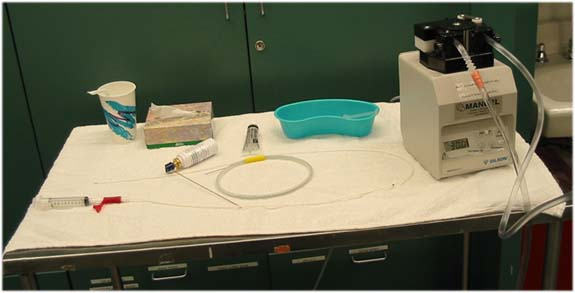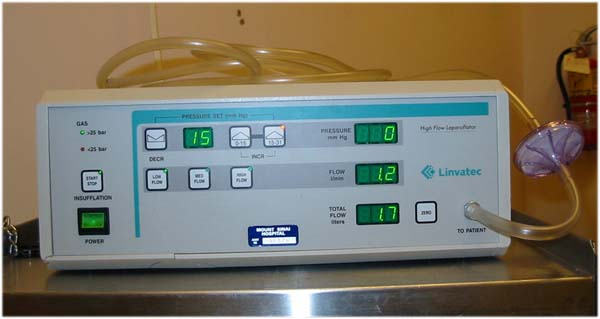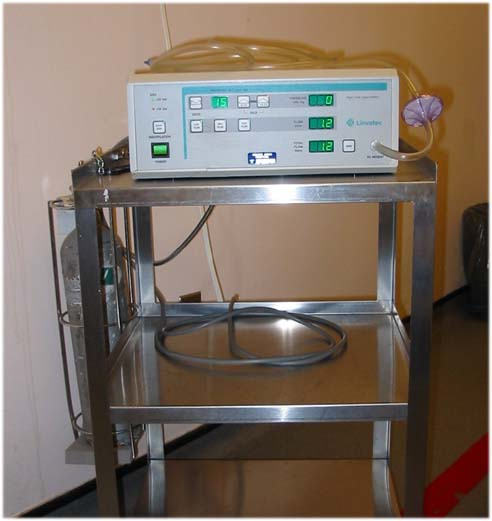Small Bowel Enema Pump
MINIPULS 3 (MANDEL) FLUID FLOW RATES
This peristaltic infusion pump is used for small bowel enema and CT
enteroclysis.
Flow rate selections and adjustment will determine the flow rate of
liquids.
- Selection of Flow Rates:
- This is dependent upon the tube diameter and pump speed
(revolutions per minute)
- The tube size and material will also determine the flow
rate.
- There are five flow charts with different tube sizes.
- It is manufacturer’s suggestion to use middle range tube
sizes to get a middle range speed and flow rate.
|
 |
- Cam Pressure (Adjustment):
- Adjusting the cam pressure on the tubing to a MINIMUM is
necessary to ensure pumping of fluid.
- The compression cam pressure can be adjusted using the
adjustment screw.
- Method:
- Slowly tighten the screw until the pump starts pumping
liquid inside the peristaltic tubing
- Then tighten again approximately 1/8 of a turn.
- Do not over tighten the screws.
|
|
Minipuls Infusion Pump Flow Rate - Large Tube Sizing.pdf
Minipuls Infusion Pump Flow Rate - Large Silicone Tube.pdf |
|
 |
|
Small bowel enema table setup |
CO2 Insufflation Pump
|
 |
|
Infusion pump with air filter |
|
 |
|
CO2 infusion pump setup |
Colonic Insufflation - Precautions regarding Pressurized
Insufflation Cadaver Studies
- Burt studied pneumatic rupture
of the colon in cadavers found that:
- Pressure at which colonic serosal
laceration occurs depends on the location in the colon.
- Rupture pressure ranged from 99 mmHg in
the rectum to 40 mmHg in the cecum.
- Kozarek et al. published similar
findings with cadaver studies:
- Serosal tearing of the colon
occurred:
- With intraluminal pressures beginning
at 52 mmHg
- The cecum requiring lowest pressure for
perforation
Double Contrast Barium Enema
- Diner et al. studied intracolonic
pressures during filled column and air contrast barium
enema:
- Colonic pressure during filling
with contrast ranged from 20-25 mmHg at the sigmoid to
30-33 mmHg at the ascending colon.
- Increases in colonic pressure
were reported as follows:
- Straight leg raising resulted in pressures
averaging 40-43 mmHg
- Valsalva maneuvers 57-63 mmHg, and patient
motion 43-50 mmHg
- Short et al. measured the intracolonic
pressure of 100 patients during double contrast enema,
and found:
- The onset of uncomfortable fullness
corresponded to an average pressure of 23 mmHg.
- Pressure levels 30 mmHg often result in
unsolicited complaint of pain.
- The onset of uncomfortable fullness, when
associated with steady intracolonic pressure usually corresponds
to a well-filled colon.
Colonoscopy
- Kozarek et al. reported during
colonoscopy:
- An average sustained intraluminal
pressure of 22 mmHg.
- The maximum intraluminal pressure ranging
between 34-138 mmHg.
- Intermittent pressure increases were due
to patient movement, patient performance of a Valsalva
maneuver, and manual pressure of the abdomen.
Conclusion
- An intracolonic pressure of
0-25 mmHg for colonic insufflation is consistent for a
safe examination and not associated with injury to the
colon. (for barium enema and colonoscopy)
References:
Burt CA. Pneumatic rupture of the intestinal canal
with experimental data showing the mechanism of perforation
and the pressure required. Archives of Surgery
1931;22:875-902.
Kozarek RA, Earnest DL, Silverstein ME, Smith RG. Air
pressure-induced colon injury during diagnostic colonoscopy.
Gastroenterology 1980; 78:7-14.
Diner WC, Patel G, Texter EC Jr., et al. Intraluminal
pressure measurements during barium enema: full column
vs. air contrast. Am J Roentgenol 1981;137:217-221.
Short WF. Moss G. Crowther JC.
Friedman RC. Horwitz RL. Manco LG. Silk PR. Manometrically
guided colon insufflation during double-contrast barium
enemas. Gastrointestinal Radiology. 10(1):85-8,
1985 |